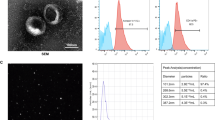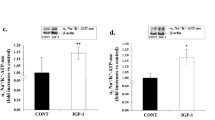Abstract
Adipose-derived stem cell (ADSC) transplantation has emerged as a potential tool for the treatment of cardiovascular disease. However, with a limited renewal capacity and the need for mass cells during the engraftment, strategies are needed to enhance ADSC proliferative capacity. In this study, we explored the effects of exendin-4 (Ex-4), a glucagon-like peptide-1 analog, on the growth of ADSCs, focusing in particular on c-Jun NH2-terminal kinase (JNK) and extracellular signal-regulated kinase (ERK) signaling pathways. Firstly, ADSCs were isolated and cultured in vitro. Then, flow cytometry demonstrated that ADSCs were positive for CD90 and CD29 but negative for CD31, CD34, and CD45. Ex-4 (0–50 nM) treatment increased ADSC proliferation in a dose-dependent manner but had no effects on stem cell markers of ADSCs. Moreover, we found that Ex-4 treatment elevated the phosphorylation levels of the JNK and ERK signaling pathways. Furthermore, utilization of Ex-4 also promoted cyclin D1 and cyclin E protein expression, which was accompanied by more Edu+ cells and a higher percentage of cells in the S-phase of the cell cycle after Ex-4 treatment. In parallel, the application of inhibitors SP600125 and PD98059, inhibitors of the JNK and ERK signaling pathways, respectively, not only reversed such effects of Ex-4 on JNK and ERK but also resulted in lower percentages of S-phase cells and fewer numbers of Edu+ cells. In summary, Ex-4 has no effects on stem cell markers in ADSCs but promotes ADSC growth via JNK and ERK signaling pathways.





Similar content being viewed by others
References
Baer PC, Schubert R, Bereiter-Hahn J, Plosser M, Geiger H (2009) Expression of a functional epidermal growth factor receptor on human adipose-derived mesenchymal stem cells and its signaling mechanism. Eur J Cell Biol 88:273–283, PubMed:19167776
Chang L, Karin M (2001) Mammalian MAP kinase signalling cascades. Nature 410:37–40, PubMed:11242034
Davidson MH (2011) Cardiovascular effects of glucagonlike peptide-1 agonists. Am J Cardiol 108:33B–41B, PubMed:21802579
Go HS, Shin CY, Lee SH, Jeon SJ, Kim KC, Choi CS, Ko KH (2009) Increased proliferation and gliogenesis of cultured rat neural progenitor cells by lipopolysaccharide-stimulated astrocytes. Neuroimmunomodulation 16:365–376, PubMed:19609085
Hausenloy DJ, Yellon DM (2012) Taking lizard saliva to heart. Eur Heart J 33:1426–1430, PubMed:21992997
Hsu LW, Goto S, Nakano T, Chen KD, Wang CC, Lai CY, Hou CH, Chang YC, Cheng YF, Chiu KW, Chen CC, Chen SH, Chen CL (2012) The effect of exogenous histone H1 on rat adipose-derived stem cell proliferation, migration, and osteogenic differentiation in vitro. J Cell Physiol 227:3417–3425, PubMed:22223405
Jeon ES, Song HY, Kim MR, Moon HJ, Bae YC, Jung JS, Kim JH (2006) Sphingosylphosphorylcholine induces proliferation of human adipose tissue-derived mesenchymal stem cells via activation of JNK. J Lipid Res 47:653–664, PubMed:16339111
Kim JH, Park SH, Nam SW, Kwon HJ, Kim BW, Kim WJ, Choi YH (2011) Curcumin stimulates proliferation, stemness acting signals and migration of 3T3-L1 preadipocytes. Int J Mol Med 28:429–435, PubMed:21519785
Li Y, Cao X, Li LX, Brubaker PL, Edlund H, Drucker DJ (2005) Beta-Cell Pdx1 expression is essential for the glucoregulatory, proliferative, and cytoprotective actions of glucagon-like peptide-1. Diabetes 54:482–491, PubMed:15677506
Liu J, Wang H, Wang Y, Yin Y, Du Z, Liu Z, Yang J, Hu S, Wang C, Chen Y (2014a) The stem cell adjuvant with Exendin-4 repairs the heart after myocardial infarction via STAT3 activation. J Cell Mol Med 18:1381–1391, PubMed:24779911
Liu J, Wang H, Wang Y, Yin Y, Wang L, Liu Z, Yang J, Chen Y, Wang C (2014b) Exendin-4 pretreated adipose derived stem cells are resistant to oxidative stress and improve cardiac performance via enhanced adhesion in the infarcted heart. PLoS One 9, e99756, PubMed:24915574
Lonborg J, Kelbaek H, Vejlstrup N, Botker HE, Kim WY, Holmvang L, Jorgensen E, Helqvist S, Saunamaki K, Terkelsen CJ, Schoos MM, Kober L, Clemmensen P, Treiman M, Engstrom T (2012) Exenatide reduces final infarct size in patients with ST-segment-elevation myocardial infarction and short-duration of ischemia. Circ Cardiovasc Interv 5:288–295, PubMed:22496084
Lundberg AS, Weinberg RA (1998) Functional inactivation of the retinoblastoma protein requires sequential modification by at least two distinct cyclin-cdk complexes. Mol Cell Biol 18:753–761, PubMed:9447971
Madonna R, De Caterina R (2010) Adipose tissue: a new source for cardiovascular repair. J Cardiovascular Med 11:71–80, PubMed:19996982
Monji A, Mitsui T, Bando YK, Aoyama M, Shigeta T, Murohara T (2013) Glucagon-like peptide-1 receptor activation reverses cardiac remodeling via normalizing cardiac steatosis and oxidative stress in type 2 diabetes. American journal of physiology. Heart and Circulatory Physiol 305:H295–304, PubMed:23709595
Morgan DO (1997) Cyclin-dependent kinases: engines, clocks, and microprocessors. Annu Rev Cell Dev Biol 13:261–291, PubMed:9442875
Sun X, Gao X, Zhou L, Sun L, Lu C (2013) PDGF-BB-induced MT1-MMP expression regulates proliferation and invasion of mesenchymal stem cells in 3-dimensional collagen via MEK/ERK1/2 and PI3K/AKT signaling. Cell Signal 25:1279–1287, PubMed:23415772
Tahrani AA, Bailey CJ, Del Prato S, Barnett AH (2011) Management of type 2 diabetes: new and future developments in treatment. Lancet 378:182–197, PubMed:21705062
Tang YL, Zhao Q, Qin X, Shen L, Cheng L, Ge J, Phillips MI (2005) Paracrine action enhances the effects of autologous mesenchymal stem cell transplantation on vascular regeneration in rat model of myocardial infarction. Ann Thorac Surg 80:229–236, PubMed:15975372, discussion 236–227
Toma C, Pittenger MF, Cahill KS, Byrne BJ, Kessler PD (2002) Human mesenchymal stem cells differentiate to a cardiomyocyte phenotype in the adult murine heart. Circulation 105:93–98, PubMed:11772882
Vacanti V, Kong E, Suzuki G, Sato K, Canty JM, Lee T (2005) Phenotypic changes of adult porcine mesenchymal stem cells induced by prolonged passaging in culture. J Cell Physiol 205:194–201, PubMed:15880640
Wagner W, Bork S, Horn P, Krunic D, Walenda T, Diehlmann A, Benes V, Blake J, Huber FX, Eckstein V, Boukamp P, Ho AD (2009) Aging and replicative senescence have related effects on human stem and progenitor cells. PLoS One 4, e5846, PubMed:19513108
Xu J, Qian J, Xie X, Lin L, Ma J, Huang Z, Fu M, Zou Y, Ge J (2012) High density lipoprotein cholesterol promotes the proliferation of bone-derived mesenchymal stem cells via binding scavenger receptor-B type I and activation of PI3K/Akt, MAPK/ERK1/2 pathways. Mol Cell Biochem 371:55–64, PubMed:22886428
Zhang D, Guo M, Zhang W, Lu XY (2011) Adiponectin stimulates proliferation of adult hippocampal neural stem/progenitor cells through activation of p38 mitogen-activated protein kinase (p38MAPK)/glycogen synthase kinase 3beta (GSK-3beta)/beta-catenin signaling cascade. J Biol Chem 286:44913–44920, PubMed:22039048
Zhou H, Yang J, Xin T, Li D, Guo J, Hu S, Zhou S, Zhang T, Zhang Y, Han T, Chen Y (2014) Exendin-4 protects adipose-derived mesenchymal stem cells from apoptosis induced by hydrogen peroxide through the PI3K/Akt-Sfrp2 pathways. Free Radic Biol Med 77:363–375, PubMed:25452142
Zhu ZQ, Wang D, Xiang D, Yuan YX, Wang Y (2014) Calcium/calmodulin-dependent serine protein kinase is involved in exendin-4-induced insulin secretion in INS-1 cells. Metabolism: Clinical and Experimental 63:120–126, PubMed:24140090
Acknowledgments
The present study was performed in accordance with the Declaration of Helsinki and the guidelines of the Ethics Committee of the Chinese PLA (People’s Liberty Army) General Hospital, Beijing, China.
Author information
Authors and Affiliations
Corresponding author
Additional information
Editor: Tetsuji Okamoto
Ying Zhang, Shi Chen, Baichuan Liu, Hao Zhou and Shunyin Hu contributed equally to this work.
Rights and permissions
About this article
Cite this article
Zhang, Y., Chen, S., Liu, B. et al. Exendin-4 promotes proliferation of adipose-derived stem cells through ERK and JNK signaling pathways. In Vitro Cell.Dev.Biol.-Animal 52, 598–606 (2016). https://doi.org/10.1007/s11626-016-0003-7
Received:
Accepted:
Published:
Issue Date:
DOI: https://doi.org/10.1007/s11626-016-0003-7




